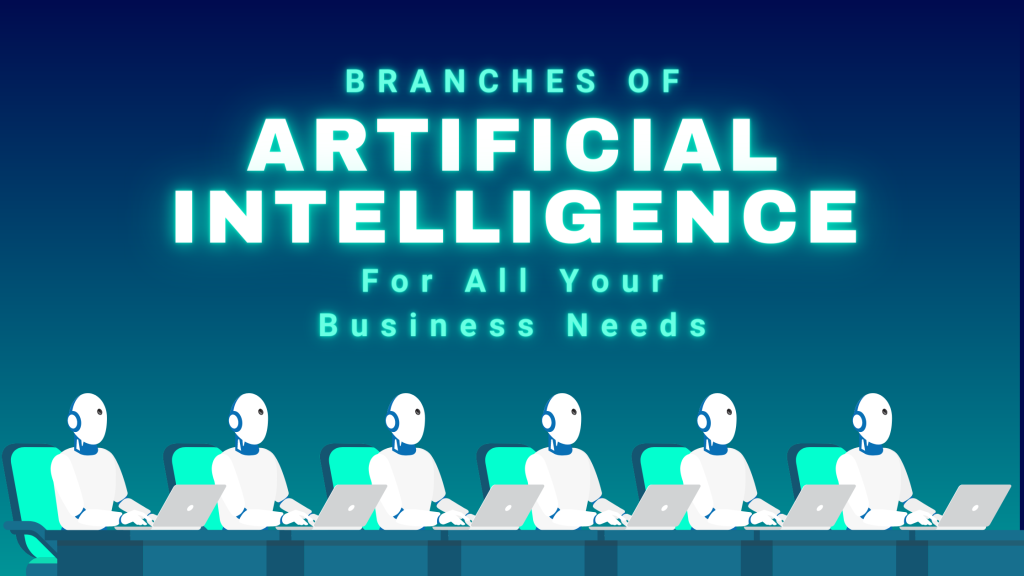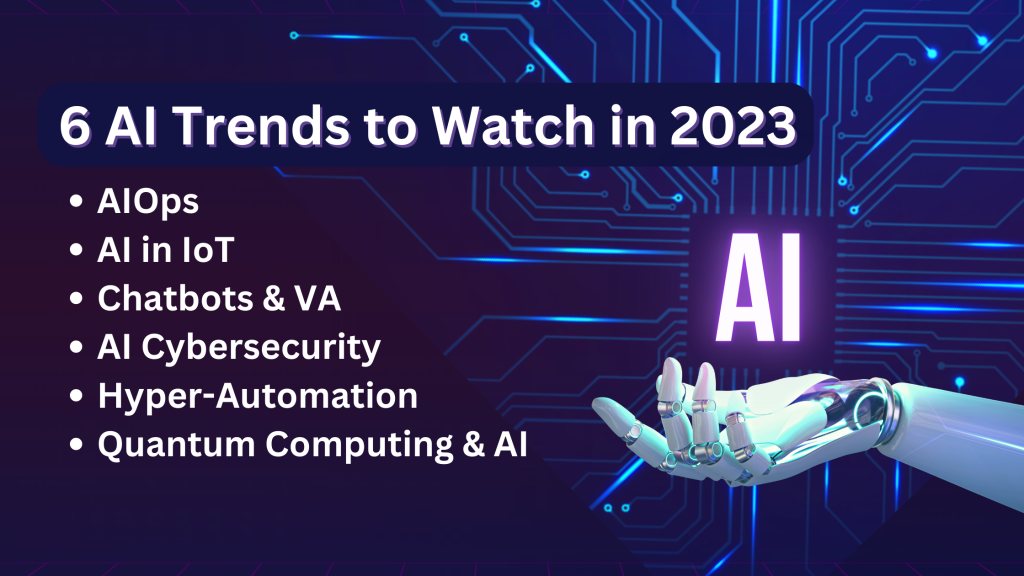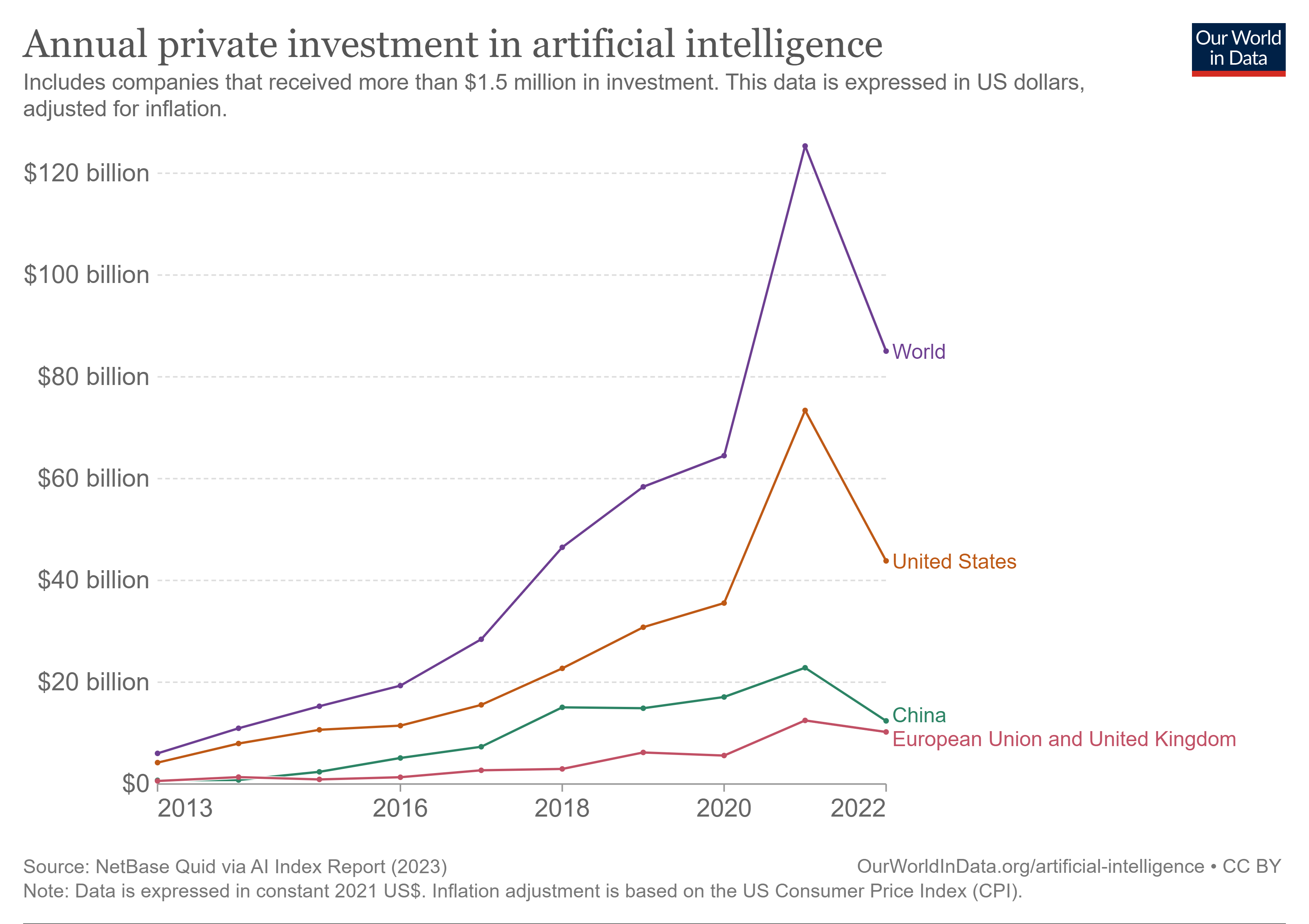As per the Global State of AI (Artificial Intelligence) 2023, 87% of enterprises believe AI/ML is important in achieving business goals. Evidently, market leaders acknowledge AI’s capability in revolutionizing industries across the board.
The transformative technology has brought us to the inflection point of Industrial Revolution 4.0, comparable to the early days of the Internet. Wherein, those who adopted the technology rode to significant success levels like Netflix. On the other hand, those who dilly-dallied, struggled, and even perished.
So, how can you do it? How can you integrate such a powerful technology seamlessly into your existing business without derailing it? This blog answers all these troublesome questions of yours.
But before that, heads up. In the next 5-10 years, branches of AI like Business Intelligence, Hyperautomation, ML, DL, and others will alter the face of businesses to an unrecognizable extent. AI will transform businesses end-to-end. It will change decision-making to execution, expedite communication, and enhance business operations. You name it, AI boosts it.
So, if you are a business, you need to act now. For now, read this comprehensive blog for a complete picture and get all your questions answered.
Reasons Why AI Has Finally Arrived And Is Here To Stay
In 2023, the market value of AI stood at $150.2 billion. And, with an expected CAGR of 36.8%, it is anticipated to reach up to $1,345.2 billion by 2030. The high CAGR states that the impact of AI is increasing with each passing day.
There are several factors contributing to Al’s phenomenal growth run. Prominent among them are greater computing power, huge data availability, widespread cloud technology, and AI techniques advancements. In this section, we will discuss the reasons why AI is here to stay.
Materialization of Moore’s Law is Powering AI
Dating back to the 1970s, Moore’s Law was a groundbreaking observation by Intel co-founder Gordon Moore. The law is an experienced prognostication that talks about the doubling of the number of transistors on microchips approximately every year or two.
Ever since its inception, the law stood the test of time and we saw rapid progress in computing power. This resulted in the availability of increasingly powerful and faster microchips at more affordable prices.
The implications of this relentless advancement in hardware and processing capabilities were monumental for the AI field. Now, AI algorithms are equipped to handle even the most complex tasks by processing massive volumes of data at unprecedented speed and efficiency.
Consequently, it has rendered AI applications more efficient, accurate, and accessible across a diverse range of industries and businesses.
Huge Data Volume Availability to Train AI for Performance and Precision
Another factor underpinning AI’s influence is the availability of huge data volume. The digital age has ushered in an explosion of data generation. As a result, loads of data volume are sourced from various origins such as social media, internet transactions, IoT devices, etc.
The data feeds AI systems to make them increasingly powerful and effective. AI systems learn in quality and quantity improving their decisions and predictive analytics. Over time, AI algorithms improve their accuracy and provide more valuable insights for businesses.
Democratization of AI with Cloud Computing
Cloud technology’s integration with artificial intelligence ignited significant transformations by shifting data and application storage to remote servers. Thus, by eliminating the need for large upfront investments in specialized hardware and software, cloud technology ensures cost-effective access to cutting-edge AI services. Thereby, allowing businesses to scale with ease and agility.
Additionally, cloud-based AI solutions offer democratization of the technology. It has leveled the playing field, enabling even small and medium-sized enterprises to harness the power of AI without financial constraints.
Latest Advances for increasingly Adept, Intellectual and Sensible AI Systems
Researchers and engineers have forged new algorithms and models leading to a profound enhancement in AI’s performance and functionalities. Breakthroughs such as Deep Learning(DL), Natural Language Processing(NLPs), Reinforcement Learning, and Generative Adversarial Networks (GANs) have served as instrumental milestones, revolutionizing the AI landscape.
As a result, AI attained unprecedented levels of intellect, adeptness, and comprehension of intricate information. The technology is now capable to perform tasks for industries across the board that were once deemed beyond possibility.
Real-World Applications and Success Stories
Artificial Intelligence (AI) applications, coupled with remarkable success stories, have significantly contributed to the widespread adoption of AI technologies.
From data analysis and pattern recognition to natural language processing and decision-making, AI offers an array of solutions that cater to specific requirements across industries. Success stories showcasing tangible benefits, such as increased efficiency, reduced costs, and enhanced customer experiences, have captured the attention of decision-makers, fostering a strong incentive for further AI adoption.
Furthermore, AI’s ability to automate repetitive tasks and streamline complex processes has led to considerable time and resource savings. This newfound efficiency translates to a competitive advantage for businesses, enabling them to redirect resources toward innovation and higher-value tasks.
Success stories emerging worldwide have also played a crucial role in demystifying AI. Initially perceived as complex and inaccessible, concrete examples of how AI has been successfully implemented have alleviated apprehensions and skepticism. This increased understanding has encouraged more businesses to explore AI solutions that align with their goals, further amplifying its impact.
The collective effect of these applications and success stories has been a positive feedback loop, perpetuating AI’s expansion across businesses and industries. We will discuss these use cases in detail in the later sections of this blog. Stay with us.
Supportive Ecosystem and Investment Underpinning AI Progress
Another important factor contributing to AI growth is the development of a conducive ecosystem. Governments, academia, and private industries are recognizing the potential of AI to drive economic growth and societal progress.
As a result, there is a growing focus on creating supportive ecosystems for AI research, development, and adoption. Investments in AI startups, research institutes, and AI-driven initiatives have amplified the momentum of AI and its impact. This has set a virtuous cycle in motion churning out innovation and technological advancement.
As AI becomes an integral part of modern business strategies, its potential to empower decision-makers, and reshape the way we live and work has become evident. Thus, we are sure that, Al along with its various branches has finally arrived at the scene. Smart are those who adopt before others.
Read the next segment to understand the various branches of AI and explore their powerful business capabilities.
Branches of AI: For All Your Business Needs

There are various branches of AI such as Machine Learning, Computer Vision, Natural Language Processing, and others. Each of these is bringing unique contributions to business advancements and improvements. They are helping businesses by expediting operations with greater efficiency, facilitating well-founded decision-making, and helping business better serve their audience.
In this section, we will discuss different branches of AI and see different examples of their working in different business spaces.
Machine Learning (ML) to Revolutionize Decision Making and Personalization
Machine learning focuses on training AI systems to learn and improve from experience. It bypasses the need for explicit programming saving huge business resources. With ML, AI systems take decisions on their own based on past experiences. The process is so integral to AI that many times the terms are either used together as AI/ML or even interchangeably.
ML algorithms help businesses analyze vast amounts of data efficiently, enhance decision-making processes, and offer personalized customer experiences. The impact of machine learning on businesses is profound, especially in finance, healthcare, retail, and manufacturing.
To get clarity, we can take the example of the finance industry. Here, machine learning models are predicting market trends and identify investment opportunities. Machine learning algorithms analyze vast amounts of financial data and identify patterns to predict market trends.
This leads to informed investment decisions that yield the highest possible returns. J.P. Morgan, in its detailed analysis, shares how hedge funds can utilize ML models to optimize investment strategies.
Natural Language Processing (NLP) to Transform Business Communication and Customer Experiences
NLP is an incredible technology that facilitates direct interaction between machines and humans. It enables machines to comprehend, interpret, and generate human language, making interactions between humans and computers more seamless than ever.
The applications of NLP span across customer service, language translation, sentiment analysis, and content generation. By leveraging NLP, businesses better understand their customers, automate customer support, and improve communication strategies. Thereby, delivering customer satisfaction and gaining customer loyalty.
For example, customer service chatbots powered by NLP can handle customer inquiries effectively and efficiently, providing 24/7 support. A travel agency can use an NLP-powered chatbot to assist customers in finding suitable travel packages. The chatbot would answer queries about destinations and attractions. Not only this, it can even help in booking flights and hotels and enhance the overall customer experience.
Deep Learning (DL) for High-level Recommendations and Intelligent Interactions
Deep learning is yet another subset of machine learning that involves artificial neural networks and multiple layers of data processing. It has applications such as image and speech recognition, recommendation systems, and autonomous vehicles.
For businesses, deep learning has significant offerings like enhancing product recommendations, optimizing supply chain management, and streamlining quality control processes. The deep learning algorithms improve customer retention and drive sales through personalized experience and much more.
The healthcare industry is a great example to showcase the capability of Deep learning. DL algorithms analyze medical images like X-rays and MRIs, aiding in the early detection of diseases. According to a recent meta-analysis, deep learning algorithms do an equally good, if not better, job compared to a human healthcare specialist.
Robotics Bringing New Heights of Efficiency and Precision to Businesses
Robotics, a combination of AI and physical machines, has brought about a revolution in industries like manufacturing, logistics, and healthcare. By integrating robotics into their operations, businesses achieve incredible benefits.
In manufacturing, for example, robots play a key role in assembling products with remarkable accuracy and speed. They handle repetitive tasks flawlessly, reducing errors and boosting productivity. Imagine a robot assembling intricate electronic devices with precision, ensuring each product is perfect!
Similarly, in the logistics sector, robots help in optimizing warehouse management and streamline the supply chain. They efficiently move and organize goods, ensuring timely deliveries and minimizing delays. Thus, making the logistics process seamless and smooth.
Even in healthcare, robots excel as vital assistants to surgeons. They bring the precision of the highest levels to delicate procedures, thereby, minimizing risks and improving patient outcomes. You can think of a robot assisting a surgeon in minimally invasive surgery. It will navigate with incredible accuracy to provide the best possible care.
In a world where efficiency and precision are paramount, robotics has emerged as a game-changer for businesses. With robots as reliable partners, industries experience new levels of success and growth, ushering in innovation and advancement.
Business Intelligence: Smart Business Moves to Beat Competition with Ease
AI-powered Business Intelligence (BI) is like having a super-smart data operative. It helps organizations uncover hidden insights from massive amounts of data. This helps businesses make data-driven decisions that go a long way in contributing to and boosting unprecedented business growth.
Businesses are foreseeing growth opportunities, anticipating customers’ demands, and optimizing strategies to outshine competitors. All this is because AI-driven BI tools are highly incredible in analyzing larger data sets to offer predictive analytics, market analysis, and identify future trends.
For retail companies, BI can analyze customer purchasing behavior to reveal which products will see higher sales. With such valuable information, retailers can stock up on the right products in time, avoiding empty shelves and maximizing sales. Customers will be delighted to find exactly what they need when they need it!
Computer Vision: Visual Machine Intelligence Adding Sense to Business
Computer vision is a remarkable technology that enables machines to “see”. That means it empowers machines to interpret and understand visual information. Thus, playing a major role in applications, such as facial recognition, security systems, as well as autonomous vehicles.
Imagine walking into a store, grabbing what you need, and simply walking out without waiting in lines. It’s a frictionless shopping experience that saves time and effort and brings a whole new level of convenience.
For security, computer vision is a true game-changer. It enhances surveillance by swiftly identifying potential threats and tracking intruders. With this advanced technology, security teams can respond promptly and keep a watchful eye on their premises.
Besides, computer vision works wonders in retail by monitoring shelves and ensuring that they are perfectly stocked and organized. This enables retailers to maintain an optimal display of products and respond quickly to restocking needs. Consequently, it ensures that customers find what they need every time they visit.
The possibilities with computer vision are endless, promising a world where visual information is harnessed to transform industries and improve lives.
Artificial General Intelligence (AGI): Redefining Human-Machine Collaboration and Achievement
Artificial General Intelligence (AGI) aims to create systems with human-like cognitive abilities. AGI-driven machines possess the same general intelligence as humans. This includes the ability to reason, learn, and adapt to new situations, and much more.
Such machines could take on tasks that currently require human expertise and creativity. Such tasks can be as complex as research projects or creative as art, and composing music.
In the education sector, for example, AGI could offer personalized learning experiences tailored to each student’s unique needs and learning style. AGI-powered systems could adapt teaching methods, pacing the curriculum to match each student’s strengths and weaknesses. Thereby resulting in more effective and efficient learning outcomes, empowering students to reach their full potential.
AGI’s potential impact on businesses, education, research, and creative fields is profound. It holds the promise of unlocking new frontiers in human-machine collaboration and shaping a future where machines and humans work together to achieve remarkable feats. The possibilities are limitless, and the world awaits the potential of AGI with great anticipation.
Reinforcement Learning: The Trial and Error of Autonomous AI
Reinforcement learning is a fascinating branch of AI that operates on a simple yet effective concept of learning through rewards and punishments. This is comparable to how we humans learn from trial and error. This approach has found diverse applications in robotics, gaming, and autonomous systems, bringing AI to the practical ground.
For businesses, reinforcement learning opens up a world of possibilities by optimizing business processes. In logistics, reinforcement learning algorithms fine-tune delivery routes for packages. As a result, businesses achieve faster deliveries and reduced transportation costs, benefiting both businesses and customers.
Amazon, the American multinational, is already exploring the use of reinforcement learning to enhance its delivery operations.
Further, reinforcement learning plays a vital role in training autonomous vehicles such as Tesla. This machine-learning technique is an emerging frontier in the automotive industry. By using this approach, AI models can learn to navigate roads and make split-second decisions, ensuring safer and more reliable autonomous driving experiences.
Moreover, reinforcement learning empowers businesses to create adaptive software systems. These AI-powered systems can continuously learn and improve based on their interactions with users and their environment. The software evolves and becomes more user-friendly with every interaction, fascinating isn’t it?
Data Mining: Unravelling Complex Patterns for Data-Driven Business Success
Data mining is a fundamental process used to unearth meaningful patterns and interconnections within extensive data sets. Its application extends across various industries and enables businesses to gain valuable insights, detect irregularities, and streamline operations. Through the practice of data mining, businesses can derive significant benefits and achieve competitive advantages.
For marketing, data mining plays a pivotal role in identifying specific customer segments and facilitating targeted campaigns that resonate with the unique preferences and behaviors of each group. By leveraging data mining techniques, businesses can optimize their marketing efforts, leading to higher conversion rates and improved customer loyalty.
In the manufacturing sector, on the other hand, data mining proves indispensable for enhancing production efficiency and quality control. By scrutinizing large datasets, manufacturers can pinpoint areas where inefficiencies and defects occur, allowing them to implement strategic improvements and optimize their production processes. Eventually, reducing waste, enhancing product quality, and increasing overall productivity.
Moreover, one of the most significant applications of data mining lies in the e-commerce industry. By harnessing the power of data mining algorithms, e-commerce platforms can analyze customer browsing history, purchase patterns, and preferences.
Consequently, these platforms can offer personalized product recommendations, presenting customers with items that are more likely to align with their interests. This level of personalization enhances the customer experience, fosters loyalty, and boosts sales for the e-commerce platform.
Artificial Neural Network (ANN) Transforming Medical Analysis, Language, and Vision
Artificial Neural Networks represent advanced computing systems inspired by the intricate neural structure of the human brain. Their utilization spans diverse applications, including image and speech recognition, as well as natural language processing, showcasing their versatility and immense potential.
ANNs have emerged as transformative tools, revolutionizing various domains like medical image analysis, language translation, and facial recognition systems, elevating accuracy and efficiency to unprecedented levels.
Further, incorporating ANNs has proven instrumental in revolutionizing multiple disciplines, particularly in natural language processing and image recognition.
In the marketing space, ANNs bring significant value by proficiently analyzing vast amounts of social media data to discern prevailing trends and gauge sentiment toward a brand. This valuable insight empowers businesses to optimize their marketing strategies, fostering an improved brand perception and a deeper understanding of customer preferences.
6 AI Trends to Watch in 2023

The race to adopt AI is on. From Big Tech like Amazon, Google, and IBM to promising start-ups, an increasing number of businesses are deploying AI with each passing day.
Either they have a dedicated research unit for AI or they are reaching out to AI development services providers like Queppelin. With experts on their side, businesses are safely exploring AI and integrating customized AI solutions aligned to their business needs and goals. AI Development service providers simplify the complex technology and help businesses identify ways to integrate it, and even execute it on their behalf.
Either way, AI’s pervasive influence in the business landscape is continuously expanding. And, in the coming times, several key AI development trends are set to revolutionize how businesses operate and interact with their customers. In this section, we will explore how businesses will use AI in the coming times and help you choose the right AI option for your business.
AI-powered Chatbots & Virtual Assistants: Redefining Customer Satisfaction and Loyalty
AI-powered chatbots and virtual assistants have become integral components of modern customer service and engagement strategies. By leveraging natural language processing (NLP) and machine learning algorithms, businesses can create chatbots capable of handling complex customer queries, streamlining support processes, and providing personalized recommendations.
These AI-driven virtual assistants offer round-the-clock assistance, ensuring seamless customer interactions and improved customer satisfaction.
For example, Starbucks uses chatbots to supplement human employees and enhance their user experience. They added this as a feature in their application “My Starbucks Barista” to help users place orders via voice command or messaging interface, thereby, delivering unparalleled speed and convenience, and enhancing customer loyalty and engagement.
Hyper-automation and its Transformational Impact on Workflows
Hyper-automation, the convergence of AI, machine learning, and robotic process automation (RPA), is redefining how businesses approach efficiency and productivity. By automating repetitive tasks across various workflows, hyper-automation empowers organizations to enhance operational agility, reduce errors, and reallocate resources to more strategic initiatives. The combination of AI and automation is enabling businesses to achieve unprecedented levels of productivity and innovation.
For instance, a global manufacturing company is utilizing hyper-automation to streamline its production line. AI-powered robots now handle repetitive assembly tasks, ensuring precise and efficient manufacturing processes.
Therefore, it frees human workers from mundane tasks, so they can focus on more important and complex tasks such as innovation, product design, and problem-solving. These results in accelerated product development and improved overall efficiency.
AI-driven Cybersecurity to Shield Against Sophisticated Cyber Threats
As the digital landscape continues to expand, the sophistication and frequency of cyber threats have risen exponentially. Malicious actors, armed with advanced tools and techniques, are constantly seeking vulnerabilities to breach systems, steal sensitive data, and disrupt critical operations. Traditional cybersecurity measures, while effective to a certain extent, are often challenged by the speed and complexity of modern cyberattacks.
AI, with its ability to process vast amounts of data in real time and identify complex patterns, is uniquely suited to detect and mitigate cyber threats that might otherwise remain undetected by human analysts or traditional security tools.
AI algorithms are trained on massive datasets containing both normal and anomalous behavior. This enables them to develop a deep understanding of what constitutes “normal” activity within an organization’s network. Any deviations from this baseline are flagged as potential security breaches, triggering immediate responses to contain and neutralize threats.
Additionally, one of the key strengths of AI-driven cybersecurity lies in its ability to learn and adapt over time. As new cyber threats emerge, AI algorithms can quickly learn from the latest attack patterns and update their defenses accordingly. This adaptability allows organizations to stay ahead of cyber adversaries and remain resilient in the face of ever-changing threats.
Furthermore, AI-driven cybersecurity solutions can provide valuable insights and actionable intelligence to security teams. By analyzing vast quantities of data, AI algorithms can identify weak points in an organization’s security posture, highlight potential vulnerabilities, and recommend proactive measures to enhance overall security.
AI-driven cybersecurity is particularly valuable for organizations with limited resources and staff. It can act as a force multiplier, enabling small and medium-sized enterprises to implement robust cybersecurity measures without the need for extensive cybersecurity expertise.
AIOps: A Smarter Approach to Automated IT Management
Artificial Intelligence for IT Operations or AIOps is a revolutionary trend that optimizes IT operations by combining big data, machine learning, and AI capabilities. It empowers IT teams to automate routine tasks, gain actionable insights from vast datasets, and detect and resolve system issues proactively. By using AI to analyze and interpret operational data, businesses can achieve enhanced system reliability, reduced downtime, and improve overall IT performance.
For example, a large software company utilizes AIOps to streamline its IT operations. Accordingly, the AI-powered system continuously monitors the performance of various software applications, servers, and network infrastructure. It detects potential issues before they escalate, allowing the IT team to proactively address them and prevent service disruptions for their customers.
Integration of AI & IoT: Power of Smart Data for Enhanced Business Efficiency
The integration of AI and the Internet of Things (IoT) is unlocking new possibilities for businesses across sectors. AI-enabled IoT devices can collect and analyze data in real-time, facilitating predictive maintenance, optimizing supply chain management, and enhancing overall operational efficiency. Additionally, AI-driven insights from IoT-generated data help businesses make data-driven decisions, resulting in increased productivity and reduced costs.
For instance, a smart city initiative incorporates AI and IoT to improve urban planning and traffic management. Smart traffic lights equipped with AI algorithms analyze real-time traffic data to optimize traffic flow, reducing congestion and travel times.
Additionally, AI-enabled sensors monitor waste management systems, optimizing waste collection routes and minimizing environmental impact.
Quantum AI: The Next Generation Computational Solutions for All Businesses
The emergence of Quantum Computing is poised to revolutionize computational capabilities exponentially. And with the conjunction of AI, Quantum AI algorithms promise to solve complex problems that are currently beyond the reach of classical computers. From drug discovery and financial modeling to supply chain optimization, quantum computing integrated with AI opens new frontiers in technology and offers unparalleled potential for innovation.
For example, a pharmaceutical company is harnessing the power of quantum computing and AI to accelerate drug discovery. Quantum algorithms can simulate complex molecular interactions more efficiently than classical computers, significantly speeding up the drug development process.
AI then helps analyze the vast amount of generated data, leading to the identification of potential drug candidates with higher precision.
AI Across Industries: Real World Use Cases and Impact

We have touched upon the various aspect of AI revolutionizing businesses in this section, we will take things into further detail and see how AI is finding utility in different areas of different industrial sectors.
AI in Healthcare: Enhancing Diagnostics, Treatment, and Patient Care
The healthcare industry has embraced AI to transform patient care, diagnostics, and treatment methodologies. AI-powered medical imaging, predictive analytics, and personalized treatment plans have revolutionized healthcare outcomes.
Additionally, AI’s ability to analyze patient data and medical literature has significantly accelerated medical research. This section will highlight the various ways AI is enhancing healthcare services and contributing to better patient outcomes.
Personalized Marketing with AI: Hyper-Targeted Customer Experiences
AI’s impact extends beyond healthcare into marketing, where it has revolutionized the way businesses interact with customers. Through the analysis of vast amounts of customer data, AI algorithms can predict consumer preferences and behavior, facilitating hyper-targeted customer experiences.
This level of personalization enables businesses to offer product recommendations and targeted marketing campaigns tailored to each individual’s interests and needs.
For example, entertainment provider Netflix leverages AI to recommend content to their users based on their browsing history, search patterns, and other behavior and preferences. This not only enhances the customer experience but also drives sales and increases customer loyalty.
Similarly, AI-powered chatbots in the customer service domain can interact with customers in a personalized manner, addressing their queries promptly and efficiently.
However, the use of AI in marketing raises important considerations related to consumer privacy and data protection. As AI algorithms rely on vast amounts of personal data, businesses must prioritize data security and transparency.
Implementing robust data protection measures and obtaining explicit user consent for data usage is crucial to build and maintain trust with customers.
AI and Cybersecurity: Strengthening Defenses Against Evolving Threats
In an era where cyber threats are constantly evolving, AI plays a vital role in strengthening cybersecurity. AI-driven cybersecurity systems can identify potential vulnerabilities, detect anomalies, and respond to threats in real-time, ensuring greater protection for sensitive data and critical infrastructure.
AI algorithms can analyze network traffic patterns to identify unusual behaviors that might indicate cyber attacks, such as malware or unauthorized access attempts. By learning from past attacks, AI can adapt and evolve its defense mechanisms, making it a powerful tool to stay ahead of cyber threats.
For instance, financial institutions employ AI-powered fraud detection systems to detect suspicious transactions and protect customers from fraudulent activities. AI can analyze transactional data in real-time, identifying patterns indicative of fraudulent behavior and triggering immediate alerts to prevent financial losses.
Despite its effectiveness, AI-powered cybersecurity also raises concerns about potential adversarial attacks where malicious actors could exploit AI vulnerabilities. Hence, continuous monitoring, regular updates, and collaboration between human experts and AI systems are crucial to maintaining strong cybersecurity defenses.
AI and Robotics: Paving the Way for Intelligent Automation
AI-powered robotics is revolutionizing automation in industries like manufacturing, logistics, and agriculture. Robots equipped with AI can perform complex tasks with precision, efficiency, and safety, reducing human intervention and minimizing errors.
In manufacturing, robots can carry out repetitive and labor-intensive tasks with high accuracy, leading to increased productivity and reduced production costs. For instance, car manufacturers use robotic arms to weld car bodies, improving manufacturing speed and product quality.
In logistics, AI-powered robots assist in warehouse operations, efficiently picking and packing products for shipping. These robots can navigate through warehouse environments, optimizing inventory management and order fulfillment.
Furthermore, in agriculture, AI-driven robots can autonomously monitor and tend to crops, making agriculture more efficient and sustainable. These robots can analyze crop health, identify pests, and apply precise amounts of fertilizers and pesticides, leading to improved crop yields and resource conservation.
As AI-powered robotics continue to advance, industries will witness increased efficiency, safety, and cost-effectiveness, leading to a transformative impact on the workforce and job roles.
AI in Education: Transforming Learning and Student Success
AI is making significant strides in the education sector, offering adaptive learning platforms, intelligent tutoring systems, and data-driven educational insights. These advancements are revolutionizing the learning experience for students and educators alike.
Adaptive learning platforms powered by AI can personalize educational content to meet the unique needs and learning styles of individual students. By continuously assessing a student’s performance and adapting the content accordingly, AI can provide personalized learning paths that optimize knowledge retention and engagement.
Intelligent tutoring systems use AI algorithms to analyze student responses, identify learning gaps, and provide real-time feedback and guidance. This individualized support enhances students’ understanding of complex topics and fosters self-directed learning.
Moreover, AI’s data analysis capabilities assist educators in identifying struggling students, monitoring their progress, and intervening early to address academic challenges. Educators can use data-driven insights to tailor instructional strategies, improving overall student success rates.
However, the implementation of AI in education comes with challenges, such as data privacy concerns and the need for ensuring equitable access to AI-driven educational resources. Ethical considerations, such as data security and transparency, are crucial to building trust and ensuring the responsible use of AI in the educational domain.
AI in Finance: Enhancing Risk Management and Financial Decision-Making
AI is transforming the finance sector by improving risk management, fraud detection, and financial decision-making. AI-powered algorithms can analyze market trends, predict investment opportunities, and optimize trading strategies. Additionally, AI-based chatbots are revolutionizing customer service in the banking industry, providing instant support and personalized assistance to customers.
AI-driven risk management systems assess and quantify financial risks in real-time, helping financial institutions make informed decisions. For example, AI algorithms can analyze credit data to assess a borrower’s creditworthiness and determine the appropriate loan terms.
Moreover, AI also plays a significant role in fraud detection, analyzing transactional data to identify suspicious activities and potential fraud attempts.
Thereby, it helps protect customers and financial institutions from financial losses due to fraudulent transactions.
In the investment industry, AI-powered algorithms can process vast amounts of market data to identify potential investment opportunities and optimize trading strategies. Hedge funds and asset management firms utilize AI to gain a competitive edge in the financial markets.
Additionally, AI-based chatbots enhance customer service in the banking sector by providing instant responses to customer inquiries and assisting with various banking transactions. This improves customer satisfaction and reduces the burden on human customer support representatives.
However, the adoption of AI in finance raises regulatory and ethical considerations, particularly concerning algorithmic transparency, fairness, and accountability. Ensuring that AI-driven financial decisions align with regulatory guidelines and ethical standards is essential to build and maintain trust in the financial industry.
AI and Creativity: The Role of AI in Art, Music, and Content Creation
AI’s capabilities are not limited to data analysis and problem-solving; it has also made significant strides in creative fields, such as art, music, and content creation. AI-generated art, music compositions, and content curation have opened new avenues for creativity and expression.
AI-driven algorithms can generate visual artworks, ranging from paintings to digital graphics, that emulate the styles of famous artists or explore entirely new artistic concepts. For instance, artists and designers use AI to create unique patterns and designs, inspiring new forms of artistic expression.
In the music industry, AI-powered systems can compose music, mimic various music styles, and even collaborate with human musicians. AI-generated compositions have been used in film soundtracks, video games, and advertising campaigns, showcasing AI’s potential to revolutionize music production.
Moreover, in content creation, AI algorithms can generate written articles, news summaries, and social media posts, streamlining content curation for online platforms. AI-powered content curation enhances efficiency and enables companies to deliver personalized content to their target audiences.
The use of AI in creative industries has sparked debates about the role of AI in artistry and its impact on human creativity. While AI-generated works showcase the capabilities of AI algorithms, some argue that human creativity and emotional depth remain irreplaceable aspects of artistic expression.
The Road Ahead: Preparing for the Exciting Future of AI Development Services
As AI development services continue to evolve, organizations must prepare for the exciting opportunities and challenges that lie ahead. AI’s potential future advancements hold promise for various industries, from healthcare and finance to education and creative fields.
One of the key areas of focus for the future of AI development is responsible AI implementation. Ethical considerations, such as bias mitigation, algorithmic transparency, and privacy protection, are crucial to ensuring AI systems operate fairly and equitably.
Additionally, organizations must prioritize AI safety and security to prevent adversarial attacks and safeguard against potential vulnerabilities. Continuous research and development in AI cybersecurity will be vital to protect AI systems from potential breaches and misuse.
Furthermore, interdisciplinary collaboration between AI developers, domain experts, and policymakers will be essential to harness AI’s potential. It will help in addressing complex global challenges, such as climate change, healthcare access, and economic inequalities.
Indeed, the future of AI development brings with it questions about the impact of AI on the workforce and society. Organizations must be proactive in reskilling their workforce to adapt to AI-powered technologies and find innovative ways to utilize AI for job creation.
In conclusion, the integration of AI into various industries has ushered in an era of transformative advancements and opportunities. From healthcare and marketing to finance and creative fields, AI’s capabilities are reshaping industries, enhancing efficiency, and improving customer experiences. However, embracing AI must address ethical considerations and data privacy concerns for a positive and promising future. As organizations and policymakers prepare for the exciting road ahead, responsible AI development services will play a pivotal role in unlocking AI’s full potential. And it will not be for a person, business, or industry, it would be for the benefit of society as a whole.






